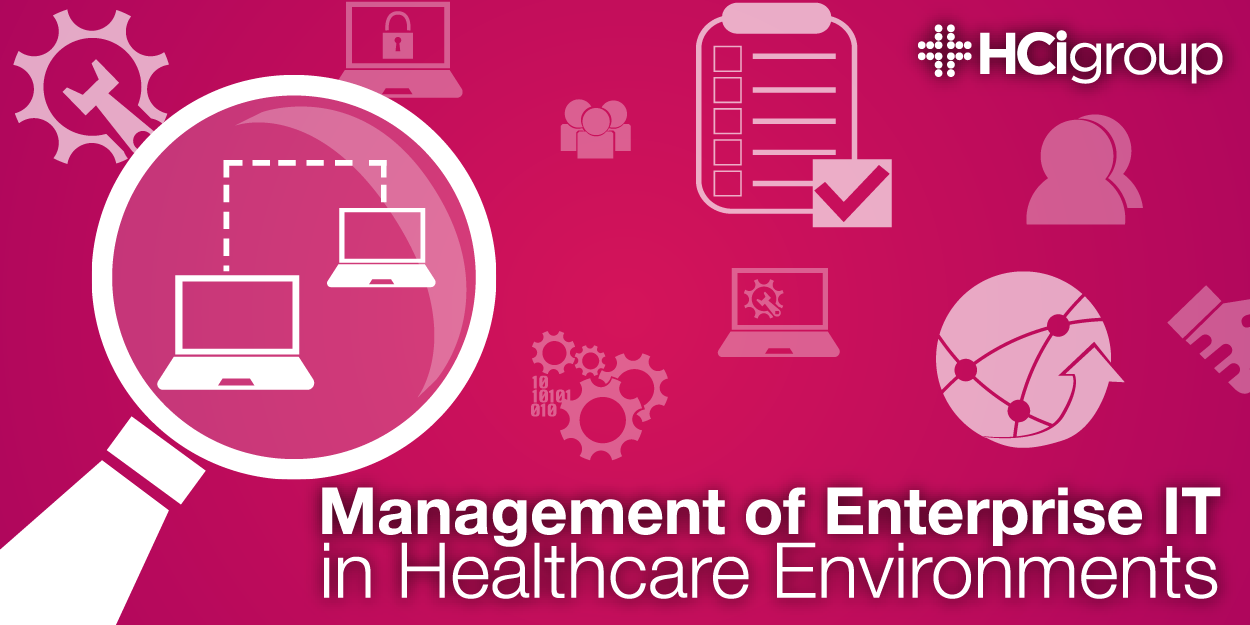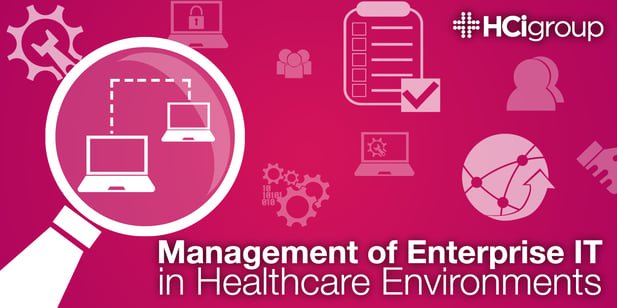Management of Enterprise IT in Healthcare Environments

Enterprise management continues to be a challenge in healthcare IT; this is a critical part of maintaining the stability and reliability of clinical and financial systems that support the delivery of healthcare services. Deploying proactive monitoring and administration of all hospital infrastructure and application technology must evolve with the dynamic healthcare ecosystem that seems to change daily.
This includes network devices, servers, storage, network circuits, interfaces and in some cases applications and job/batch processes. When systems experience failures, it is critical that monitoring agents quickly trap the event and escalate based on established rules in the monitoring application. It’s important that these rules are properly defined and configured for the hospital environment.
In this post, Ken Bradberry - SVP of Managed Services Operations and Innovation gives his perspective on both the challenges and solutions of managed service solutions.
Wouldn't it be great to have the ability to event correlate all the alerts and quickly pinpoint the root cause of the problem? Systems and devices attached to the hospital network should be properly identified and monitored based on criticality to the delivery of patient care and stable hospital operations. This includes the following:
Hardware Monitoring
Common Information Model (CIM) enabled monitoring like what is used by VMware ESX and other Hardware vendors like HPE Systems Insight Manager or Dell's Open Manage solution provide functionality that reports the status of hardware components such as power supplies, fans, adapters and disk to ensure all fault tolerant components are properly managed.
Comprehensive Performance and Capacity Monitoring
Nagios, Solarwinds, NetIQ and Microsoft Systems Center Operations Manager (SCOM) suites of tools to track CPU, memory, I/O, network and a host of other vital performance metrics for performance and capacity management. These tools must be configured to identify performance bottlenecks and failures, and must be useful in the root cause analysis process. In many cases, healthcare systems make large investments in these tools and they are never configured to their full potential. Many of these vendors are now integrating A.I. and Machine Learning capabilities to become more proactive.
Operating System Administration
Patching, security updates, anti-virus, security administration and disk management are vital to maintaining healthy servers and applications.
Storage Monitoring and Administration
Monitoring SAN fabrics, storage devices, server HBA, disk and disk controller firmware levels, as well as file system, logical volumes, volume groups and other vital storage architecture are a critical part of administration.
Network Monitoring and Administration
This type of monitoring and administration should identify slow or failing components in the network topology including circuits, core and edge devices. This should also include route analytics and the performance and health of protocols utilized on the network. Proactively monitoring the network can help ensure small problems do not evolve into large outages. Tools like Solar Winds provide comprehensive solutions that provide real-time and historical views of the networks that support healthcare.
Database Monitoring and Administration
Monitoring databases is a critical part of application health. Keeping track of performance from several aspects of the database can ensure proper tuning and the detailed forensics necessary for troubleshooting performance and corruption problems. For example, the loss of a single hard drive in a RAID environment will not result in the loss of service, but it does result in a loss of redundancy. If corrective action isn’t taken, the next failure will result in a loss of service. Monitoring and proper escalation is critical to maintaining the proper fault tolerance and stability.
It is unacceptable for medical IT devices or systems that are connected to the network to have inadequate protection – with little or no system monitoring or administration – and lack of processes to monitor, alert and correct problems in a timely fashion.
New systems should never be introduced into a clinical environment without inventory, inspection and administration; healthcare IT systems must be properly maintained and secured.
Healthcare IT Challenges
The issues paramount to healthcare IT is security, protection, cost, quality, all directly impact customer satisfaction
Cybersecurity
Is patient data secured and protected? Healthcare data has become very valuable to cyber criminals; having a solid security strategy is essential. This includes properly backing up data and patching all systems and applications.
Protection
Is the network monitored, and are the systems protected from virus and other malicious applications?
Cost
Without a valid backup, restoring service can take time, money and possibly result in canceled cases and loss of patient data and a damaged reputation.
Quality
Loss of patient data, delayed diagnosis, treatment, duplication of exams that can affect the care of quality of services provided.
Customer Satisfaction
Downtime results in canceled cases, delays in diagnosis and treatments, aggravating patients, physicians and the departments.
HIT Managed Services Solutions
Many of the services and the tools required to support healthcare IT can deployed as a managed service that provides a single point of administration, resulting in reduced costs and higher quality than what is achievable in today’s healthcare IT environment. Managed services solutions will include many of these advanced monitoring and management capabilities. In many healthcare IT organizations, the tools are deployed but not configured to their potential.
For IT leadership, it’s of paramount importance to have complete visibility into the health of your client’s environment and take immediate corrective action when gaps are identified. Areas to focus include, but are not limited to:
- Backup and Recovery Disaster Recovery
- Patch Management Solutions
- Antivirus
- Directory Services/Account Security
- HL-7 and DICOM Interfaces
- Network Monitoring (LAN/WAN/Cloud)
- HIPAA Compliance
- Real-time Monitoring and Notification Rules
- Reporting Capabilities/Generating Useful Reports
- Asset Management for Servers, Desktops and Network
- Management of Bio-medical Devices
- IT Service Management Integration
- Enterprise Bus Architectures
Continuous improvement is vital to our continued advancement of healthcare IT services. What is the situation at your site? It’s worth exploring how Managed Services Solutions can dramatically improve the health of your IT infrastructure and delivery of clinical applications.
Additional Healthcare IT Managed Service Solutions Resources:
- Checkout this blog post about how Achieving Cost Savings with Healthcare IT Managed Services
- Read more about HCI's Infrastructure Management Services offerings
Schedule a time to speak with our Managed Services Team by completing the contact form below.


